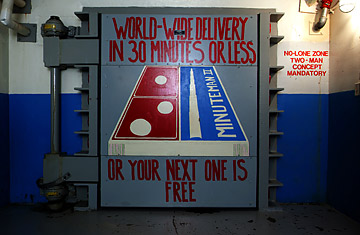
A scene from Countdown to Zero
Countdown to Zero, which opened July 23, originally premiered at the Cannes Film Festival. Here is Mary Corliss' earlier review.
Cannes is light on big Hollywood names this year. The absence of Brad Pitt and Angelina Jolie, frequent, luminous presences, or Clint Eastwood or George Clooney, has left the red carpet outside the Palais des Festivals a bit more drab. Sean Penn will be testifying on Haiti before a Congressional committee in Washington, D.C., instead of visiting the Riviera to support his Hollywood docu-drama Fair Game, in which he plays Joseph C. Wilson to Naomi Watts' Valerie Plame. But Plame herself — blonde, radiant and poised — was in town, to promote both Fair Game and Lucy Walker's documentary Countdown to Zero. For much of the liberal U.S. press here, the former covert operative at the center of the Bush Administration CIA leak scandal is the definition of star quality.
Plame's husband, a former U.S. foreign service diplomat, was sent to Niger to find evidence of Saddam Hussein's purchase of the uranium yellowcake needed to build a nuclear bomb; as Wilson later wrote in The New York Times, there was no such evidence. Countdown to Zero is about the threat of real weapons of mass destruction: nuclear devices that countries like Iran and Pakistan and North Korea could use against their neighbors, or that al-Qaeda and other freelance groups could detonate in the U.S. Osama Bin Laden has stated his desire for 4 million dead, 2 million of whom will be children. That much human destruction could and can only be accomplished by a nuclear device.
The film, produced by the World Security Institute and the History Channel, is the familiar massing of clips, charts and talking heads. It does not aspire to high art or headline-making exposé. But it does efficiently and vigorously enumerate the dangers of nuclear proliferation by governments and rogue entities. We all could blow at any minute — as John F. Kennedy said, "through mistakes, miscalculations, and madness."
Nuclear bombs are fairly simple to assemble, if enough enriched uranium is available; and that is easier to steal, or buy, than to make. After the Soviet Union dissolved in 1989, plutonium could be obtained by simply smashing the lock on a storage shed. ("Potatoes are guarded better," says one Russian expert.) To smuggle weapons-grade material into the U.S., all you'd need to do is bury it inside a lead pipe and hide it in a giant container of canned goods on any freighter entering a port city. Transporting them is also no problem, since 100 pounds of highly enriched uranium, enough to crater New York City, could fit inside a football.
At the center of three decades of worries is the Islamic state of Pakistan. When India, its adjacent enemy, went nuclear, a Pakistani leader said, "We will make the bomb, even if we have to eat grass." Soon Pakistan joined the nuclear club and — through one evil genius, the engineer A.Q. Khan — spread the technology to North Korea, Iraq and Libya. "Got a problem?" someone says in Countdown to Zero. "Call 1-800-AQ-KHAN."
The newer and aspiring members of the nuclear club have arguments on their side. Only one nation, the U.S., has dropped a nuclear weapon on another country. And if nine nations can officially possess The Bomb, then why can't 12 or 15 or 50? "If it's a good thing, why don't you share it?" asks Iranian President Mahmoud Ahmadinejad. "If it's a bad thing, why should you have it?" The only answer from the old guard: We can be trusted not to push the button; you can't.
One bombmaker with a conscience was J. Robert Oppenheimer, the American physicist who directed the Manhattan Project during World War II, which created the first atom bomb. His triumph was melancholy. Quoting the Bhagavad Gita, he said, "Now I am become Death, the destroyer of worlds." Sixty-five years later, the world is still here, but cataclysmic destruction is more of a threat than ever.
The facts marshaled by Plame and the film's other advisers make Countdown to Zero a stirring and scary reminder of the nuclear sword hanging over our collective neck. It details the potential horrors befalling a nuclear attack on New York City, and the deadly fallout that would destroy countless lives, not to mention any residue of a social order in the rest of the nation. And the only comfort may be in the title of an old Tom Lehrer song about nuclear Armageddon: "We will all go together when we go." The film ends with a zero message to embrace: no country should have nuclear weapons.
